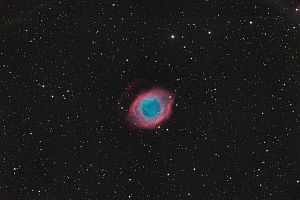Galaxies south of Helix is the topic of Part #8 of our image presentation, where we want to share the results from our astrophotography-trip to the Hacienda Los Andes in Chile.
The Helix Nebula (NGC 7293) is a large planetary nebula located in the constellation Aquarius and is one of the closest to the Earth of all the bright planetary nebulae. The estimated distance is about 215 parsecs (700 light-years). It is similar in appearance to the Cat's Eye Nebula and the Ring Nebula. The Helix Nebula has sometimes been referred to as the "Eye of God" as well as the "Eye of Sauron". The white dot at the Helix's center is this Planetary Nebula's hot, central star.
IC 1459 is a rarely imaged elliptical S0 galaxy (i.e. large bulge with a minimal or faint disk) about 70 million light-years from Earth located in the constellation of the Grus, close the border with Piscis Austrinus and Sculptor. It is an object of 11 mag easily visible in amateur telescopes and is the leading member of a small group of galaxies formed mostly by spiral galaxies.
IC 5201 is another faint spiral galaxy in constellation Grus which has been discovered in 1900. We were not able to find much information about IC 5201, so we just can say: enjoy the image! Once again in constellation Grus we can find NGC 7531, a spiral galaxy about 60 million light-years away, which has been discovered by John Herschel in 1836. This southern galaxy is one of the brightest and largest examples of a "nonbarred", ringed system.
NGC 6752 is a globular cluster in the constellation Pavo. It is the third-brightest in the sky, after Omega Centauri and 47 Tucanae. Over 10 billion years old it holds over 100 thousand stars in a sphere about 100 light-years in diameter. Telescopic explorations of the NGC 6752 have found that a remarkable fraction of the stars near the cluster's core, are multiple star systems. They also reveal the presence of blue straggle stars, stars which appear to be too young and massive to exist in a cluster whose stars are all expected to be at least twice as old as the Sun. The blue stragglers are thought to be formed by star mergers and collisions in the dense stellar environment at the cluster's core.
NGC 6744 is an intermediate spiral galaxy about 30 million light-years away in the constellation Pavo. It is one of the galaxies most similar to our Milky Way in the local universe and therefore sometimes called the Big Brother to the Milky Way. Big Brother? Yes, NGC 6744 is bigger than the Milky Way, with a disk stretching 175,000 light-years across! It also has at least one distorted companion galaxy (NGC 6744A) which is similar to our galaxy's Large Magellanic Cloud.
The last image shows constellation Indus which is located in the southern hemisphere. It does not contain any bright stars. Its brightest stars are only of third magnitude. The constellation represents the Indian, referring to a native of either of Asia or the Americas at the time the constellation was created in the late sixteenth century. All Sky Automated Survey for SuperNovae (ASAS-SN) detected a superluminous supernova, named ASASSN-15lh (also designated SN 2015L) in 2015. Based on a study by the Kavli Institute for Astronomy and Astrophysics (KIAA) at Peking University, ASAS-SN-15lh was two times more luminous than any supernova previously discovered, and at peak was almost 50 times more luminous than the entire Milky Way galaxy.
Finaly an amazing full day-night-day video from our timelapse photographer Justin Kabaus:









